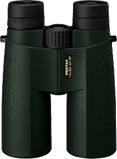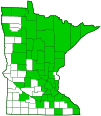Canada darner
(Aeshna canadensis)
Conservation • Description • Habitat • Ecology • Distribution • Taxonomy
Conservation Status |
|||
| IUCN Red List | LC - Least Concern |
||
| NatureServe | N5 - Secure SNR - Unranked |
||
| Minnesota | not listed |
||
Description
Canada darner is a large mosaic darner (genus Aeshna). It occurs across the northern United States and southern Canada. It is the most common blue darner in Minnesota, where it occurs throughout the state except for the western prairie counties. It is a late-season dragonfly, not appearing until late June and flying to the end of September.
Adults are 2⅝″ to 2⅞″ (68 to 74 mm) long. The body is dark brown with blue, green, or yellow markings that darken in cool temperatures. Males always have mostly blue markings. Females have three color forms; blue, green, and yellow. Most females are green form. Blue form females are rare.
There are two large compound eyes on the sides of the head and three small simple eyes (ocelli) in a triangle on the top of the head. The compound eyes of both sexes meet along a long margin at the top of the head. The antennae are tiny. The face is pale green. Like all mosaic dragonflies, there is a black T-shaped spot on the upper part of the face (frons) just below where the eyes meet. This is best seen when viewed from above. There is no bold, black, horizontal stripe across the middle of the face.
The thorax of both males and females has a pair of shoulder stripes on the top and a pair of parallel lateral stripes on each side. The front (anterior) lateral stripe is deeply notched, is narrowed toward the top, and has a narrow rearward extension (flag) at the top. On the male, the anterior stripe is blue at least at the top, often fading to green on the lower end. On females, it is usually all green, sometimes mostly blue. The rear (posterior) lateral stripe is not notched. There is a small yellow spot separating the two lateral stripes.
The abdomen is slender with rows of pale spots in a mosaic pattern. On males all 10 abdominal segments have a pair of blue spots on top and a blue spot on each side. On green form females all of the spots are yellowish-green. On intermediate form females the dorsal spots are yellowish-green, the lateral spots blue. On newly emerged females all of the markings are blue. On blue form females they remain blue. On the male the pair of appendages at the end of the abdomen (cerci) are paddle-shaped when viewed from above. On females they are large and leaf-like. They do not break off during egg laying.
The wings are clear. The forewings are slightly narrower than the hindwings. The forewing and hindwing triangles are equal in size.
Size
Total length: 2⅝″ to 2⅞″ (68 to 74 mm)
Similar Species
Lake darner (Aeshna eremita) is larger. The posterior thoracic stripe is shallowly notched. There is a bold, black, horizontal stripe across the middle of the face.
Habitat
Boggy or marshy edges of slow streams, lakes, and beaver ponds.
Ecology
Season
Late June through late September
Behavior
Life Cycle
The female deposits eggs one at a time on floating vegetation or inside the stem of emergent vegetation. The larvae (naiads) reach full size in their first year. They overwinter in a state of decreased metabolic activity (diapause).
Naiad Food
Insect larvae, freshwater shrimp, tadpoles, and small fish
Adult Food
Soft-bodied flying insects
Distribution |
||
|
Sources Biodiversity occurrence data published by: Minnesota Biodiversity Atlas (accessed through the Minnesota Biodiversity Atlas Portal, bellatlas.umn.edu, 11/23/2025). Haarstad, J. 1997. The dragonflies of selected eastern Minnesota rivers. Report submitted to the Minnesota Department of Natural Resources. Unpaged. Steffens, W. P., and W. A. Smith. 1999. Status survey for special concern and endangered dragonflies of Minnesota: population status, inventory and monitoring recommendations. Final report submitted to the Natural Heritage and Nongame Research Program, Minnesota Department of Natural Resources. 54 pp. |
|
| 11/23/2025 | ||
Occurrence |
||
very common |
||
Taxonomy
Order
Odonata (Dragonflies and Damselflies)
Suborder
Superfamily
Aeshnoidea
Family
Aeshnidae (Darners)
Genus
Aeshna (mosaic darners)
Subordinate Taxa
Synonyms
Aeschna canadensis
Anax maritimus
Common Names
Canada darner
Glossary
Cercus
One of a pair of small sensory appendages at the end of the abdomen of many insects and other arthropods. In Odonata, one of the upper claspers. Plural: cerci.
Diapause
A period of decreased metabolic activity and suspended development.
Frons
The upper front part of an insect’s face, roughly corresponding to the forehead.
Naiad
The aquatic larval form (nymph) of a dragonfly, mayfly, or stonefly.
Ocellus
Simple eye; an eye with a single lens. Plural: ocelli.
Visitor Photos
Share your photo of this insect.
This button not working for you?
Simply email us at info@MinnesotaSeasons.com.
Attach one or more photos and, if you like, a caption.
Alfredo Colon |
||
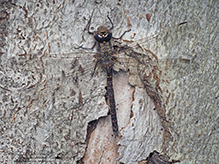 |
 |
|
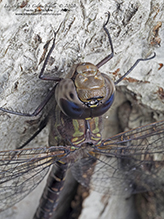 |
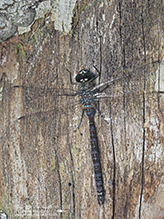 |
|
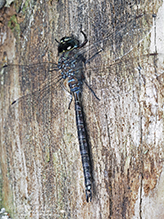 |
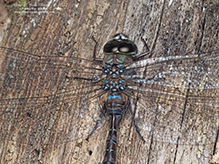 |
|
Scott Bemman |
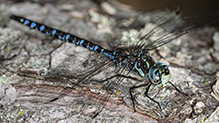 |
MinnesotaSeasons.com Photos
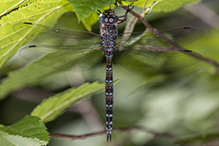 |
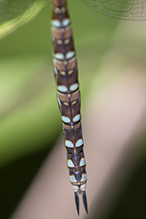 |
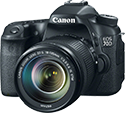
Slideshows
Canada Darner
John Sutton
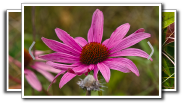
Visitor Videos
Share your video of this insect.
This button not working for you?
Simply email us at info@MinnesotaSeasons.com.
Attach a video, a YouTube link, or a cloud storage link.
Other Videos
4K UHD 60fps - Dragonfly Canada Darner (Aeshna canadensis) resting on a branch with sun shinning
The 4K Guy - Nature & Urban

Visitor Sightings
Report a sighting of this insect.
This button not working for you?
Simply email us at info@MinnesotaSeasons.com.
Be sure to include a location.
MinnesotaSeasons.com Sightings
